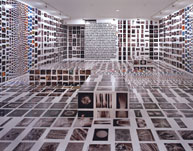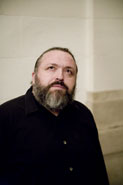Massive change: The blueprint for a design revolution
Massive change: The blueprint for a design revolution McGill University
User Tools (skip):
Massive Change
The blueprint for a design revolution
World-renowned architect Buckminster Fuller once said that the purpose of design is to "make the world work for 100 percent of people in the shortest possible time through spontaneous co-operation, without ecological offense or disadvantaging anyone."
That may well summarize the message of Toronto designer of everything from books to brands to product development, Bruce Mau, to a rapt full house at Moyse Hall on February 2. Invited by the McGill School of Environment to speak on the future of environmental design, the creative director of Bruce Mau Design and founder of the Institute without Borders (IwB) talked about the impact of good design.

Toronto designer Bruce Mau, below, packed Moyse Hall on February 2. He is the curator of Massive Change's image gallery (left), which is set up like a three-dimensional electromagnetic spectrum. The images made from low frequency waves (radio waves) are near the entrance, images made with visible light (red, orange, yellow, etc.) are in the middle of the room, and images made using high frequency waves (gamma waves) are near the exit. The show was commissioned by the Vancouver Art Gallery and has gone on to tour Toronto and will be in Chicago as of September.
Courtesy of Bruce Mau Design
Mau is particularly intrigued by the question, "Now that we can do anything, what will we do?" IwB and its first project, Massive Change, is a response to that question. It is the result of a collaborative effort between Bruce Mau Design and George Brown-Toronto City College. The IwB is a postgraduate, interdisciplinary design program in which eight students spend a year working in Mau's Toronto studio researching, designing and realizing an ambitious public project. "Design is one of the most powerful forces at work today," Mau told the Moyse Hall gathering. Indeed, Massive Change opened to rave reviews at the Vancouver Art Gallery in October 2004.
In an interview with the Reporter prior to the talk, Mau explained that the Massive Change travelling exhibit looks at design in movement (green alternatives like the electric-and-human-powered Twike and Gizmo vehicles), information technology (computer tracking the hole in the ozone layer), the military (we can thank them for the internet, Gore-Tex, freeze-dried foods and the blue-helmets of UN troops), materials (plastic that can repair itself when it cracks), and health and living (growing and reconfiguring of body parts).
Mau has worked with designers like American engineer and inventor, Dean Kamen, whose company, Deka, has come up with some of the most exceptional and revolutionary designs of the last 50 years. Kamen and his team are responsible for designing a new portable dialysis machine that gives patients more mobility; and the iBOT, a wheelchair-like system that allows users to climb stairs and negotiate uneven terrain; and the Segway; personal transportation device using lithium batteries.
Interchange of machine and final product

Bruce Mau
Claudio Calligaris
Design is not just the machine, or the product that springs from it, but a deeply collaborative process that is essential to the concept of Massive Change. "We realize that we have come to a point where our capacity to control is limitless." said Mau. "Research has shown us that there is a global move to sustainable design, which is design that resolves input and outputs - what is coming into process and, when we are finished, what the outcome is."
Clearly, Mau is no the environmental pessimist, but in Canada, where some find his optimism controversial. "We're not doing too badly," he said. "The danger in Canada is having almost a curse of natural resources," he said, citing the Alberta tar sands in particular, a potential watershed for an oil-starved world, along with the possibility of Canada contributing to increased greenhouse gases in the next 10-15 years. "What we need more of here is companies like RIN [the Canadian company that developed the now-ubiquitous BlackBerry]."
During the talk, Mau said that the mistake some designers make is to not look at design from a citizens' perspective. Making reference to Montreal's unwelcoming bus shelters struck a chord with the audience. "Why would anyone want to stand in there in this weather? What's my motivation to use public transportation?"
Mau sees cause for optimism in a world of sustainable design where more inputs and outputs are being resolved. "It means a commitment to a global open world, to diversity and to complexity. It means a new political axis is developing that's not about left versus right, not about the social versus the market. It's about a new approach that confronts us with a choice between a fearful, retrograde, closed society and a vast, courageous, open society."

